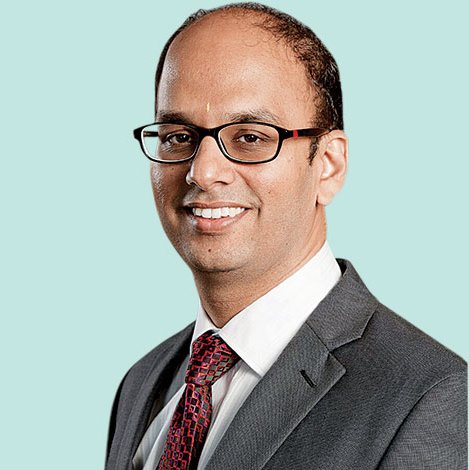
Manish Banthia, Senior Fund Manager – Fixed income, ICICI Prudential Mutual Fund has over 13 years of experience in the Indian capital market. He joined ICICI Prudential AMC in 2005 and manages the fixed income function of the AMC like fixed income trading, credit analysis and product development. A qualified Chartered Accountant, he also holds a Master’s degree in Business Administration from Indian Institute of Foreign Trade (IIFT) Delhi. Manish manages ICICI Prudential Bond Fund and ICICI Prudential Equity and Debt Fund which are recommended by Geojit.
In this exclusive interview with Geojit Insights he talks about debt market in general and particularly about the recent debt market crisis.
In the context of RBI rate cut for a third time in a row, the 10 Year G-sec yield falling to its lowest of 6.93% on 6th June and the liquidity crunch prevailing in the market, what will be your outlook on the Indian debt market on a medium and long-term perspective?
The RBI has acknowledged growth slowdown and has turned accommodative in its policy stance. This effectively means better liquidity transmission and lower interest rates.
We are of the view that improvement in liquidity conditions in the coming months would be positive for the shorter end of the yield curve. Therefore, we continue to remain sanguine towards the short end of the yield curve and on spread assets. We believe that the risk-reward benefit is still favourable in the one to four year segment of the yield curve and spread assets provide better margin of safety. The AA curve in the market still trades much higher compared to AAA and Government securities which makes it the most attractive asset class in the market right now.We believe that whenever the transmission takes place the investments into AA asset class will prove to be beneficial for the investors.
What are the strategies you follow to select good debt instruments from the market, where we had seen a “AAA” rated instruments fall to “D” ratings in a span of four months?
At ICICI Prudential AMC, we have instituted an independent Investment Risk Management team which oversees the credit evaluation and approval processes, as a means to address and mitigate credit risks. We ensure that investments are made only after conducting appropriate credit due diligence and with requisite credit approvals. Credit due diligence requirements include both qualitative (management profile, industry outlook, competitive positioning, key risks and mitigation) and quantitative (financial and operating parameters) analysis.
We have always adhered to the following philosophy in credit decision making which has proved to be helpful for our investors:
- Avoid concentration at individual scheme level.
- Focus on client selection. None of our schemes have investments in papers issued by ILFS group entities bears testimony to this.
- Have not solely relied upon external credit rating as the selection tool.
- Do not chase Yield-to-Maturity (YTM) as the sole metric indicating the potential future performance especially in case of Credit Risk Funds.
- Unlike duration funds (which generate returns through events resulting in interest rate reduction), for accrual funds to generate return, two things are important: risk-adjusted rate of return and the time period of investments.
- Approaching each credit decision purely based on the internal due diligence and factoring in liquidity risk.
- Credit investments have to be approached from a bottom-up perspective. There are good companies in bad sectors and bad companies in good sectors.
- Considering that the upside in any debt investment is capped, it may not be worthwhile to play contrarian.
Owing to all of these steps taken, ICICI Prudential has been able to deliver a positive investment experience for its investors.
Looking up on the recent events in debt funds, how does a retail investor identify when to sell his underperforming funds?
ICICI Prudential AMC had NIL exposure to troubled papers from IL&FS, Reliance Capital, YES Bank and DHFL. We believe a well-run debt fund would have investments diversified assets across sectors and should avoid concentration at individual scheme level. Such an approach is likely to help avoid adverse impact of such credit events and is likely to aid in delivering better risk adjusted returns. Owing to this approach, ICICI Prudential Credit Risk Fund has been among the better preforming funds.
With the recent uncertainties in the debt market do you believe that switching of liquid funds to overnights funds will be safer?
We do not see a problem with liquid funds. The recent uncertainty in debt market is largely related to credit and not in terms of duration. There are several portfolios which have been unaffected owing to the robust credit management practices followed by the fund house. So, one need not change their investment strategy owing to a temporary problem.
What are the asset allocation strategies you follow for managing your aggressive hybrid fund’s portfolio?
The asset allocation strategy followed by ICICI Prudential Equity and Debt Fund is as follows:
Equity:
- The scheme shall invest across market capitalization. The allocation will depend on the net equity level of the scheme as per the in-house price-to-book model. As on May 31, 2019, the exposure to large, mid and small cap stocks is 86%, 8% and 6% respectively.
- The scheme shall use a blend of top-down and bottom-up approach for stock selection.
- The scheme shall remain sector agnostic in its investment approach. For stock picking, the fund manager shall identify those stocks with long-term growth prospects but currently trading at modest to relative valuations.
- The scheme may also take derivatives exposure for portfolio hedging or any other permitted strategy with a view to minimize downside risk. As on May 31, 2019, the *net equity exposure of the scheme stands at ~70%.
*Note: The net equity exposure includes foreign equity and units of equity mutual fund.
Debt:
- The Scheme intends to tactically allocate to longer duration fixed income securities with credit rating AA and above, which offer reasonable accrual. The scheme shall take exposure in well-researched corporate securities to earn reasonable carry over wealth.
- The Scheme also invests in fixed income securities issued by the government, quasi government agencies and corporate and multilateral agencies.
The debt exposure as on May 31, 2019 stands at ~24%. Within the debt holdings, the scheme has a higher exposure towards good credit quality instruments to benefit from higher carry.
Could you please brief the risk controlling measures you adopt in your existing portfolio?
As a part of risk controlling measure, we look at liquidity management; credit management, concentration management and duration management as the fulcrum to provide better risk adjusted returns.
What are the upcoming market events that a debt investor should look forward to if he is planning to invest for a short term and medium term?
We remain watchful of any fiscal slippages, reversal in prices of any perishable food items, uncertainty regarding global events and escalating trade tensions between US and China and the upcoming Budget.










